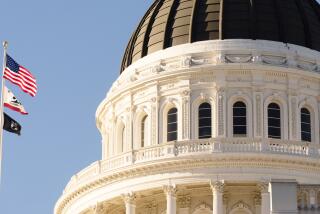Critics Expect Too-Rosy White House Growth Forecast
- Share via
WASHINGTON — The White House’s midyear economic forecast is expected to be far rosier than predictions by private economists, and critics said Friday that it would artificially lower the spending cuts called for under the Gramm-Rudman law.
Because it is usually dismissed by economists as overly optimistic, the Office of Management and Budget’s annual midyear forecast normally has little impact beyond the role it plays in shaping the budget proposed in January by President Reagan.
Key Role in Cutbacks
However, the OMB midyear report is being awaited with great interest this year because it will play a key role in determining how much to cut federal spending to meet Gramm-Rudman’s deficit-reduction targets or even if spending reductions are required at all.
“The weaker the economy looks, the more they’ve got to cut to meet the Gramm-Rudman target,” said A. Gary Shilling, who runs his own economic forecasting firm in New York.
A preliminary draft of the forecast circulated within OMB on July 8 and obtained by The Times Friday estimated the economy would grow at an inflation-adjusted 4.5% rate in fiscal 1987, which begins Oct. 1.
By comparison, the Blue Chip Economic Index--a compilation of 52 economists’ forecasts made several days after the OMB forecast--estimates growth at 3.4% for that period, using a slightly different method of calculation.
OMB officials cautioned that the numbers, reported in Friday’s New York Times, are likely to be revised somewhat when they incorporate data released this week, which indicated that second-quarter growth slowed to a sluggish 1.1% annual rate. However, economists said, the adjustment is not likely to dampen the outlook by more than a few tenths of a percentage point.
$20-Billion Difference
Thus, the difference in the deficit--and the required spending cuts--resulting from the OMB’s forecasts and the deficit that would be expected under private consensus could be more than $20 billion, said Georgia State College economist Don Ratajczak, whose own expectation is for only 2.1% growth.
The Gramm-Rudman law was designed to make the prospect of the cuts as distasteful for President Reagan as they are for Congress. The reductions come half from defense spending, which is Reagan’s highest priority, and half from domestic programs dear to congressmen.
No cuts would be called for if the deficit is projected to come within $10 billion of Gramm-Rudman’s $144-billion target. With the OMB’s preliminary economic growth forecast, it is possible that the deficit forecast will fall to that level and spare the White House and Congress from making the cuts, Shilling said.
“There’s evidence that all forecasts done by the Administration have some political tinge to them,” Ratajczak added. “It’s a good-faith effort by people who are grabbing at everything optimistic.”
“It’s questionable as to whether (a 4.5% forecast) is realistic,” said Senate Budget Committee Chairman Pete V. Domenici (R-N.M.), a chief architect of the congressional budget, based on projections of 3.1% growth. “I hope it’s true, but it seems to me to be optimistic.”
Law Averaged Forecasts
As the Gramm-Rudman law was originally written, the OMB’s forecasts would be averaged with those of the Congressional Budget Office, which are generally closer to the private consensus, before the spending cuts were ordered.
However, to correct a defect in the law that caused the Supreme Court to declare its key provision unconstitutional, the Senate is considering legislation that could give the OMB discretion to use only its own forecasts in deciding whether the cuts are necessary and how large they should be. Without a legislative change, it would require a congressional vote and President Reagan’s signature to implement the spending reductions.
More to Read
Get the L.A. Times Politics newsletter
Deeply reported insights into legislation, politics and policy from Sacramento, Washington and beyond. In your inbox twice per week.
You may occasionally receive promotional content from the Los Angeles Times.










